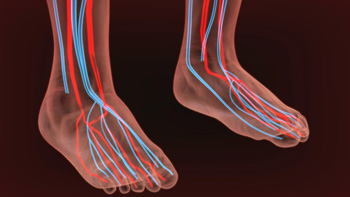Peripheral artery disease ( PAD) is a condition that causes poor blood flow to the lower extremities. This is due to a buildup of plaque along the walls of the arteries, causing them to narrow and become stiff and thus restricting blood flow. According to a recent study, people with rheumatoid arthritis (RA), an autoimmune disorder that affects the joints, appear to be at an increased risk of developing PAD. Fortunately, both PAD and RA can be managed. A podiatrist can screen for PAD and recommend treatment options for both conditions. If you have poor circulation to your lower limbs or arthritic joint pain in your feet and ankles, it is suggested that you consult with a podiatrist.
PAD) is a condition that causes poor blood flow to the lower extremities. This is due to a buildup of plaque along the walls of the arteries, causing them to narrow and become stiff and thus restricting blood flow. According to a recent study, people with rheumatoid arthritis (RA), an autoimmune disorder that affects the joints, appear to be at an increased risk of developing PAD. Fortunately, both PAD and RA can be managed. A podiatrist can screen for PAD and recommend treatment options for both conditions. If you have poor circulation to your lower limbs or arthritic joint pain in your feet and ankles, it is suggested that you consult with a podiatrist.
Peripheral artery disease can pose a serious risk to your health. It can increase the risk of stroke and heart attack. If you have symptoms of peripheral artery disease, consult with Elliot T. Udell, DPM from New York. Our doctor will assess your condition and provide you with quality foot and ankle treatment.
Peripheral artery disease (PAD) is when arteries are constricted due to plaque (fatty deposits) build-up. This results in less blood flow to the legs and other extremities. The main cause of PAD is atherosclerosis, in which plaque builds up in the arteries.
Symptoms
Symptoms of PAD include:
- Claudication (leg pain from walking)
- Numbness in legs
- Decrease in growth of leg hair and toenails
- Paleness of the skin
- Erectile dysfunction
- Sores and wounds on legs and feet that won’t heal
- Coldness in one leg
It is important to note that a majority of individuals never show any symptoms of PAD.
Diagnosis
While PAD occurs in the legs and arteries, Podiatrists can diagnose PAD. Podiatrists utilize a test called an ankle-brachial index (ABI). An ABI test compares blood pressure in your arm to you ankle to see if any abnormality occurs. Ultrasound and imaging devices may also be used.
Treatment
Fortunately, lifestyle changes such as maintaining a healthy diet, exercising, managing cholesterol and blood sugar levels, and quitting smoking, can all treat PAD. Medications that prevent clots from occurring can be prescribed. Finally, in some cases, surgery may be recommended.
If you have any questions, please feel free to contact our office located in Hicksville, NY . We offer the newest diagnostic and treatment technologies for all your foot care needs.
